Scientific name Solanum nigrum Rank Species | Genus Solanum Higher classification Solanum | |
 | ||
Similar Solanum, Nightshade, Lamb's Quarters, Solanum dulcamara, Jimsonweed | ||
European black nightshade solanum nigrum 2012 07 25
European black nightshade (Solanum nigrum) or locally just black nightshade, duscle, garden nightshade, garden huckleberry, hound's berry, petty morel, wonder berry, small-fruited black nightshade, or popolo) is a species in the Solanum genus, native to Eurasia and introduced in the Americas, Australasia, and South Africa. Parts of this plant can be toxic to livestock and humans. Nonetheless, ripe berries and cooked leaves of edible strains are used as food in some locales, and plant parts are used as a traditional medicine. A tendency exists in literature to incorrectly refer to many of the other "black nightshade" species as "Solanum nigrum".
Contents
- European black nightshade solanum nigrum 2012 07 25
- European black nightshade solanum nigrum 2012 09 02
- Description
- Taxonomy
- Toxicity
- Uses
- Culinary usage
- Medicinal usage
- Cultivation
- Weed
- References
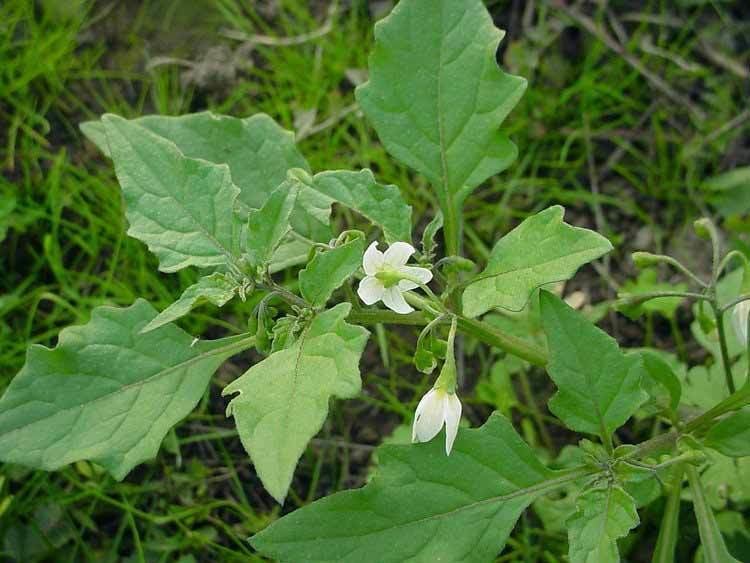
Solanum nigrum has been recorded from deposits of the Paleolithic and Mesolithic era of ancient Britain and it is suggested by the botanist and ecologist Edward Salisbury that it was part of the native flora there before Neolithic agriculture emerged. The species was mentioned by Pliny the Elder in the first century AD and by the great herbalists, including Dioscorides. In 1753, Carl Linnaeus described six varieties of Solanum nigrum in Species Plantarum.

European black nightshade solanum nigrum 2012 09 02
Description
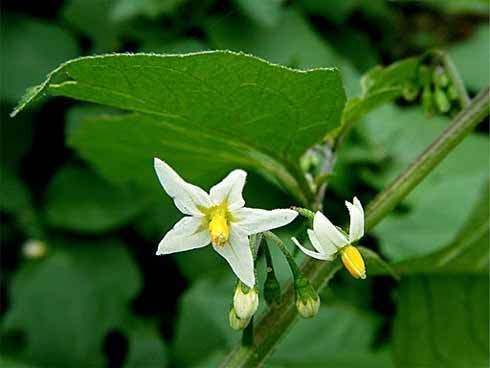
Black nightshade is a common herb or short-lived perennial shrub, found in many wooded areas, as well as disturbed habitats. It reaches a height of 30 to 120 cm (12 to 47 in), leaves 4.0 to 7.5 cm (1.6 to 3.0 in) long and 2 to 5 cm (1 to 2 in) wide; ovate to heart-shaped, with wavy or large-toothed edges; both surfaces hairy or hairless; petiole 1 to 3 cm (0.5 to 1 in) long with a winged upper portion. The flowers have petals greenish to whitish, recurved when aged and surround prominent bright yellow anthers. The berry is mostly 6 to 8 mm (0.24 to 0.31 in) in diam., dull black or purple-black. In India, another strain is found with berries that turn red when ripe.
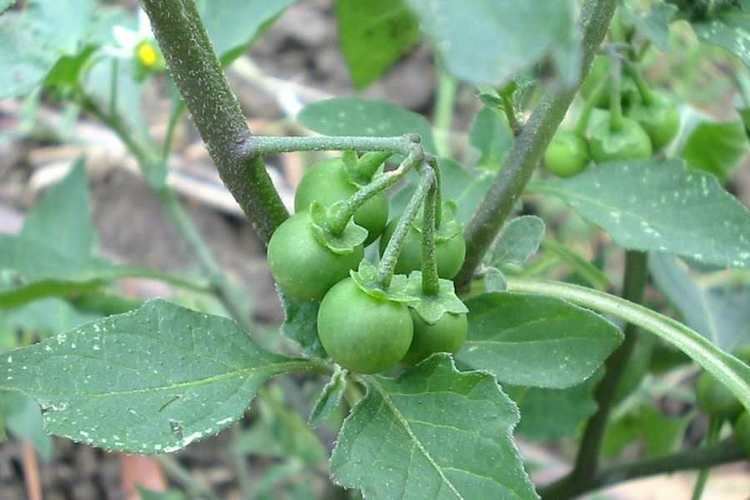
Sometimes S. nigrum is confused for the more toxic deadly nightshade, Atropa belladonna, in a different Solanaceae genus altogether. A comparison of the fruit shows that the black nightshade berries grow in bunches, the deadly nightshade berries grow individually.
Taxonomy
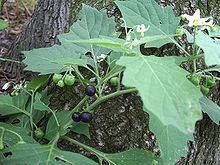
The S. nigrum species is a highly variable taxon with many varieties and forms described. The recognized subspecies are:
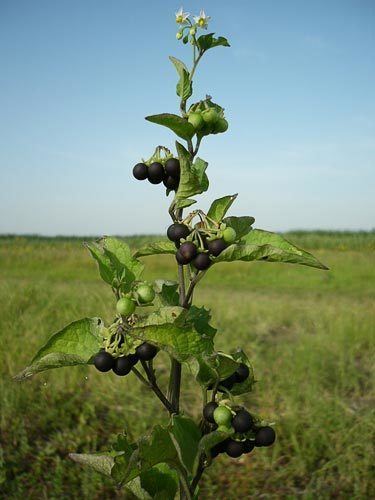
1. S. nigrum L. subsp. nigrum — glabrous to slightly hairy with appressed non-glandular hairs
2. S. nigrum L. subsp. schultesii (Opiz) Wessley — densely hairy with patent, glandular hairs
The Solanum nigrum complex — also known as Solanum L. section Solanum — is the group of black nightshade species characterized by their lack of prickles and stellate hairs, their white flowers, and their green or black fruits arranged in an umbelliform fashion. The Solanum species in this group can be taxonomically confused, more so by intermediate forms and hybridization between the species. Some of the major species within the S. nigrum complex are: S. nigrum, S. americanum, S. douglasii, S. opacum, S. ptychanthum, S.retroflexum, S. sarrachoides, S. scabrum, and S. villosum.
Toxicity
Solanine levels in S. nigrum can be toxic. Children have died from poisoning after eating unripe berries. However, the plant is rarely fatal, with ripe berries causing symptoms of mild abdominal pains, vomiting, and diarrhea.
Poisoning symptoms are typically delayed for 6 to 12 hours after ingestion. Initial symptoms of toxicity include fever, sweating, vomiting, abdominal pain, diarrhea, confusion, and drowsiness. Death from ingesting large amounts of the plant results from cardiac arrhythmias and respiratory failure. Livestock have also been poisoned from nitrate toxicity by grazing the leaves of S. nigrum. All kinds of animals can be poisoned after ingesting nightshade, including cattle, sheep, poultry, and swine. In central Spain, the great bustard (Otis tarda) may act as a seed disperser of European black nightshade (Solanum nigrum). Black nightshade is highly variable, and poisonous plant experts advise to avoid eating the berries unless they are a known edible strain. The toxin levels may also be affected by the plant's growing conditions. The toxins in S. nigrum are most concentrated in the unripe green berries, and immature fruit should be treated as toxic. Most cases of suspected poisoning are due to consumption of leaves or unripe fruit.
There are ethnobotanical accounts of S. nigrum leaves and shoots being boiled as a vegetable with the cooking water being discarded and replaced several times to remove toxins.
Uses
Some of the uses ascribed to S. nigrum in literature may actually apply to other black nightshade species within the same species complex, and proper species identification is essential for food and medicinal uses (See Taxonomy section).
Culinary usage
S. nigrum has been widely used as a food since early times, and the fruit was recorded as a famine food in 15th-century China. Despite toxicity issues with some forms, the ripe berries and boiled leaves of edible strains are eaten. The thoroughly boiled leaves — although strong and slightly bitter flavoured — are used like spinach as horta and in fataya pies and quiches. The ripe black berries are described as sweet and salty, with hints of liquorice and melon.
In India, the berries are casually grown and eaten, but not cultivated for commercial use. In South India, the leaves and berries are routinely consumed as food after cooking with tamarind, onion, and cumin seeds. The berries are referred to as "fragrant tomato". Although not very popular across much of its growing region, the fruit and dish are common in Tamil Nadu (மணத்தக்காளி in Tamil), Kerala, southern Andhra Pradesh, and southern Karnataka.
In Ethiopia, the ripe berries are picked and eaten by children in normal times, while during famines, all affected people would eat berries. In addition, the leaves are collected by women and children, who cook the leaves in salty water and consume them like any other vegetable. Farmers in the Konso Special Woreda report that because S. nigrum matures before the maize is ready for harvesting, it is used as a food source until their crops are ready. The Welayta people in the nearby Wolayita Zone do not weed out S. nigrum that appears in their gardens since they likewise cook and eat the leaves.
In Ghana, the unripe green berries are called kwaansusuaa or abedru, and are used in preparing various soups and stews, including the popular palm nut soup commonly eaten with banku or fufu'.
In South Africa, the very ripe and hand-selected fruit (nastergal in Afrikaans and umsobo in Zulu) is cooked into a beautiful but quite runny purple jam.
In Greece and Turkey, the leaves are called istifno, and in Crete known as stifno. They are one of the ingredients included in the salad of boiled greens known as horta.
In Indonesia, the young fruits and leaves of cultivated forms are used and are known as ranti (Javanese) or leunca (Sundanese). The fruit and leaves are eaten raw as part of a traditional salad lalapan, or the fruit is cooked (fried) with oncom.
It was imported into Australia from Mauritius in the 1850s as a vegetable during the gold rush, but S. nigrum is now prohibited for trade as a food by the Australia New Zealand Food Standards Code.
During ancient times in Hawaii young shoots, leaves, small white flowers, and small black berries were eaten. The leaves, among other greens, were cooked by rolling hot stones among them in a covered gourd.
Medicinal usage
The plant has a long history of medicinal usage, dating back to ancient Greece. "... In the fourteenth century, we hear of the plant under the name of Petty Morel being used for canker and with Horehound and wine taken for dropsy." It was a traditional European medicine used as a strong sudorific, analgesic and sedative with powerful narcotic properties, but was considered a "somewhat dangerous remedy". Internal use has fallen out of favor in Western herbalism due to its variable chemistry and toxicity, but it is used topically as a treatment for herpes zoster.
S. nigrum is an important ingredient in traditional Indian medicines. Infusions are used in dysentery, stomach complaints, and fever. The juice of the plant is used on ulcers and other skin diseases. The fruits are used as a tonic, laxative, appetite stimulant, and for treating asthma and "excessive thirst". Traditionally the plant was used to treat tuberculosis. It is known as peddakasha pandla koora in the Telangana region. This plant's leaves are used to treat mouth ulcers that happen during winter periods of Tamil Nadu, India. It is known as manathakkali keerai in Tamil Nadu and kaage soppu in Karnataka, and apart from its use as a home remedy for mouth ulcers, is used in cooking like spinach. In North India, the boiled extracts of leaves and berries are also used to alleviate liver-related ailments, including jaundice. In Assam, the juice from its roots is used against asthma and whooping cough.
S. nigrum is a widely used plant in oriental medicine where it is considered to be antitumorigenic, antioxidant, anti-inflammatory, hepatoprotective, diuretic, and antipyretic.
Chinese experiments confirm that the plant inhibits growth of cervical carcinoma in mice.
Solanum nigrum is known to contain solasodine (a steroidal glycoalkaloid that can be used to make 16-DPA progenitor); a possible commercial source could be via cultivating the hairy roots of this plant.
Cultivation
Black nightshade is cultivated as a food crop on several continents, including Africa and North America. The leaves of cultivated strains are eaten after cooking. A garden form with fruit 1.27 cm (0.50 in) diam. is occasionally cultivated.
Weed
Black nightshade can be a serious agricultural weed when it competes with crops. It has been reported as a weed in 61 countries and 37 crops. Herbicides are used extensively to control it in field crops such as cotton.
